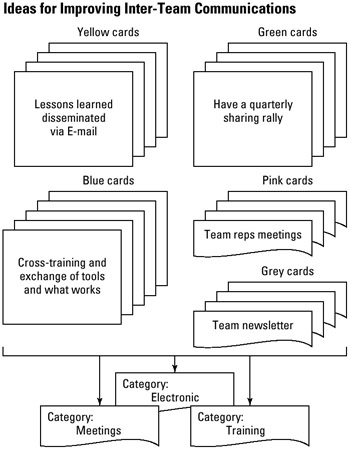Tool 134: Pin Cards Technique
| AKA | N/A |
| Classification | Idea Generating (IC) |
Tool description
Developed by Wolfgang Schnelle, the pin cards technique is a brainwriting process to generate ideas on colored cards that are categorized and displayed to all participants for further sorting and clarification. This process includes an effective idea stimulation feature that assists participants to think of more ideas during the writing process.
Typical application
-
To generate ideas to solve a problem or improve a process.
-
To allow equal participation in a team brainwriting process.
-
To produce many ideas quickly and without filtering from other participants.
Problem-solving phase
| → | Select and define problem or opportunity |
| → | Identify and analyze causes or potential change |
| → | Develop and plan possible solutions or change |
| Implement and evaluate solution or change | |
| Measure and report solution or change results | |
| Recognize and reward team efforts |
Typically used by
| Research/statistics | |
| 1 | Creativity/innovation |
| Engineering | |
| Project management | |
| Manufacturing | |
| Marketing/sales | |
| Administration/documentation | |
| Servicing/support | |
| Customer/quality metrics | |
| 2 | Change management |
before
-
Brainwriting Pool
-
Mental Imaging
-
Fresh Eye
-
Stimulus Analysis
-
Circle response
after
-
Morphological Analysis
-
Sticking Dots
-
Creativity Assessment
-
Cluster Analysis
-
Criteria Filtering
Notes and key points
-
Pin cards technique advantages:
-
It allows equal participation by all participants.
-
It produces more ideas than basic brainstorming.
-
Color-coded cards identify originator of idea (for later clarification, if needed).
-
Displayed ideas can easily be examined by all participants for combining ideas, modifying or building on each other's ideas.
-
-
Pin cards technique disadvantages:
-
Participants not passing cards quickly may cause bottlenecks in the process.
-
Participants may perceive a time pressure to generate ideas.
-
Quick passing of idea cards leave little time for idea incubation.
-
Some participants may not wish to have their ideas openly displayed.
-
Step-by-step procedure
-
STEP 1 The team facilitator displays a flip chart with the problem statement and explains how the pin cards technique is performed. See example Ideas for Improving Inter-team Communications.
-
STEP 2 Every participant receives approximately 10 cards of the same color; each participant receives different-colored cards.
-
STEP 3 Participants recheck the problem statement, ask for clarification if needed, and begin writing ideas on their cards, one idea per card. Completed cards are passed to the person on their immediate right.
-
STEP 4 Participants have the option to pick up any cards from the person on their left and read it. This may stimulate participants to think of additional ideas.
-
STEP 5 After 30–45 minutes of brainwriting, the facilitator asks all participants to collect their cards and pin them on a wall or tape them to flip charts or a whiteboard. Cards are assembled by category or common group.
-
STEP 6 Participants read all cards, move some to a matching group or category, ask for clarification on others, and continue this process until completed.
Example of tool application

EAN: 2147483647
Pages: 326